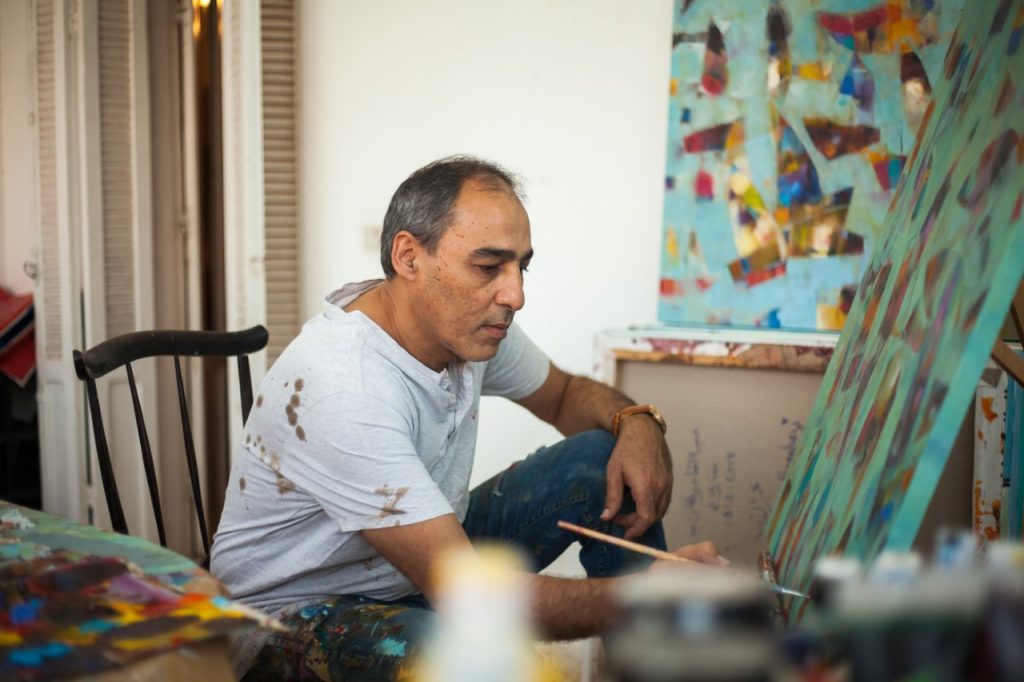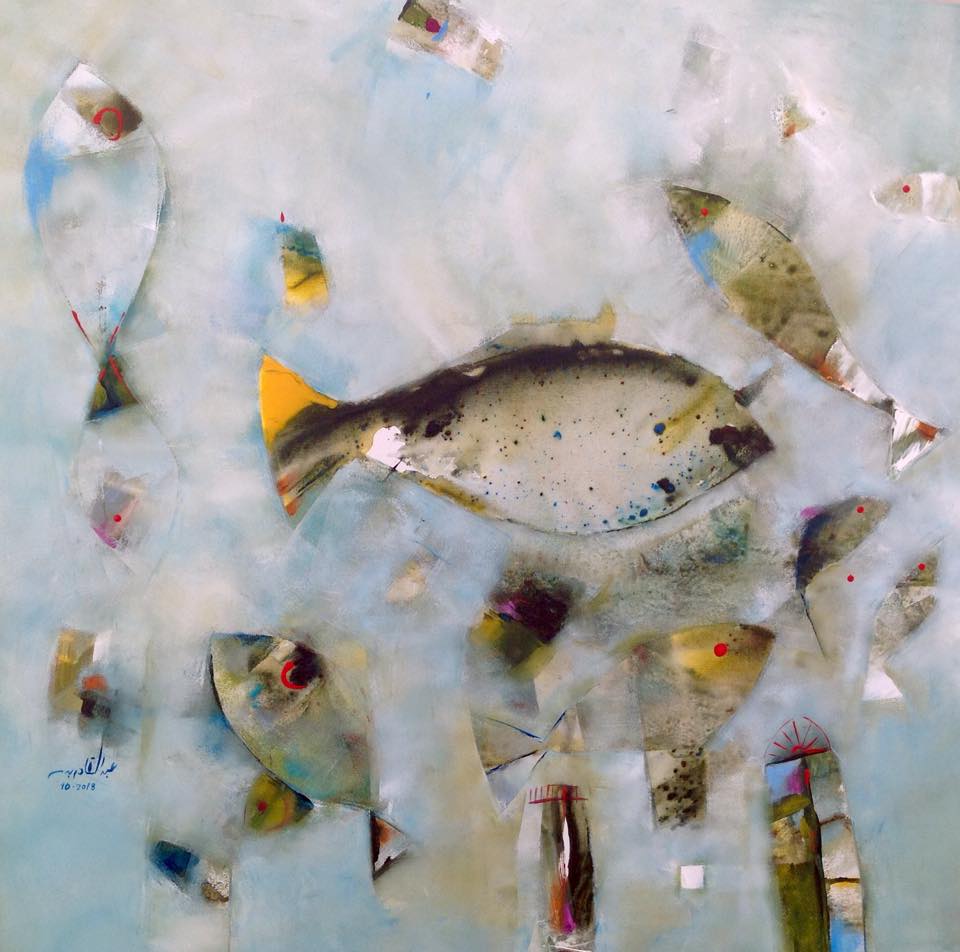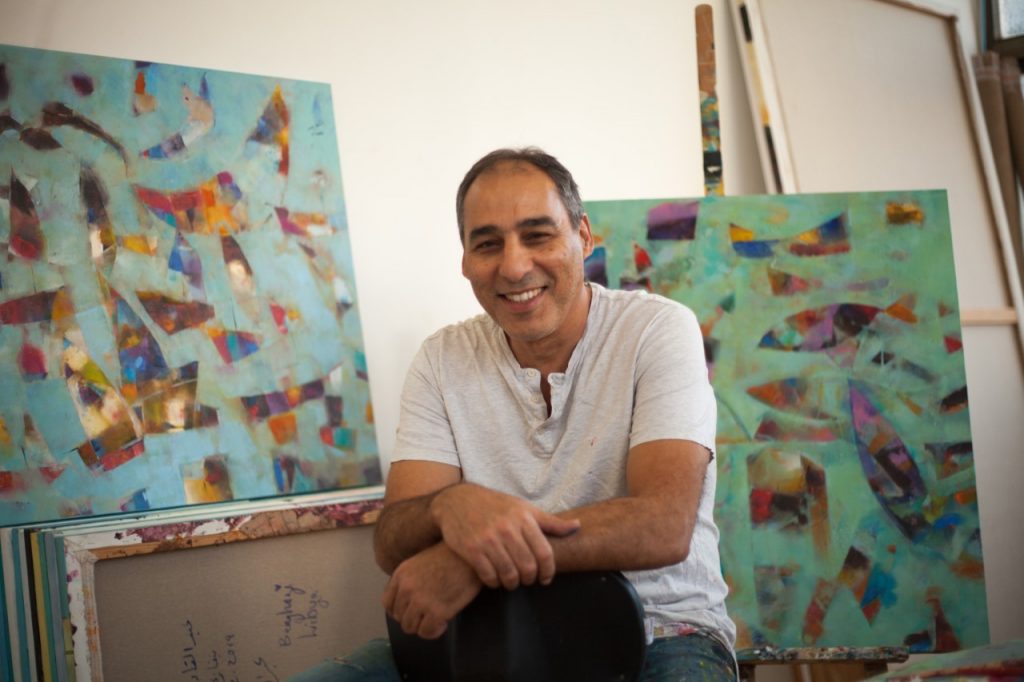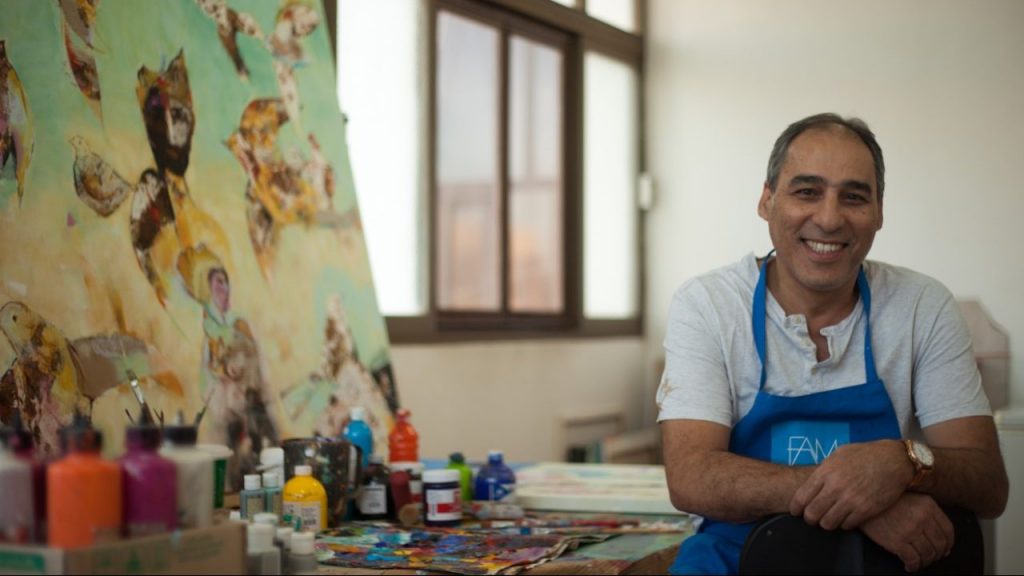MQR: We are delighted to have one of your paintings as the cover of our winter issue. Can you tell us a little bit about your life such as how you got started into painting, and where you got your training?
Abdelgader Bader (AB): My beginnings in painting were from childhood, where I grew up in a family that was interested in the arts in general (plastic arts and theater) and encouraged it. My interest in the arts continued to develop in middle and high school through extracurricular activities until university. At the University of Benghazi I joined the open studio and practiced painting there. After graduating with a B.S. Chemistry in 1986 I began to paint with oil and water colors and drew many realistic and photographic paintings and still-life, under the supervision of the late artist Mohamed Estetah, who helped guide and train many young self-taught artists in Benghazi. I never studied art formally, but I worked hard to learn and see a lot of art schools and the work of accomplished artists.

MQR: What is life like for a painter in city like Benghazi? What is the art scene like and how does the community interact with its artists?
AB: Benghazi is a cultural city with a distinct identity, and it has a lot of writers, writers, poets and artists. As I was growing up there were a lot of exhibition halls for visual arts. Artistic activity is limited compared to the large cities in the region, but there is always something happening in the arts. Society’s interaction with the artists is generally supportive; the educated elites and university students here love the arts in most of their forms.
MQR: Over the decades, Libya has lived under tense political circumstances — from dictatorship to religious extremism. What was it like to be an artist working under censorship? How did you find you subject matter and how did the atmosphere affect what you wanted to paint about and how you painted?
AB: The former regime in Libya generally did not impede the visual arts, but on the other hand, there were restrictions in the topics that an artist could address, which caused the plastic artist a lot of problems, especially comics and caricature. Basically anything touching on the leader’s personality and the political situation were prohibited. Personally, my works were and still are related to the Libyan and Arab heritage, local architecture, seascapes. And boats, due to my interest in sea. I love all water and sailing sports, and have practiced them for a long time.
MQR: The piece we’re featuring on the cover of our Winter issue features some of your recurrent imagery, i.e. fishes and doors. Can you tell us what draws you to these two images in your work?
AB: I use popular shapes, decorations and symbols that appear in the windows and doors of the old houses in Benghazi. These images originate from the environment in which I was raised. Now there is little left of them, but for me the doors represent the many, different people who lived there, the rich and the poor, the simple and the complicated, the miserable and the happy.

MQR: Fish in your work are often, though not always, represented with red eyes. It is quite an arresting affect. Is there something about the eye that interests you?
AB: Fish are an important symbol in Libyan folk art and can be found as carpets and textile decoration throughout the Arab world. They are a symbol of renewal and a sign of abundant livelihood and fertility, and a good omen for the bearer. The red eye in the fish is a talisman to protect from envy and evil. I combine them in different ways to give them new and abstract meanings.
MQR: With small exceptions, you tend not to have human beings represented in your work. Is there a reason you feel more drawn to depict the natural world?
AB: My preoccupation with abstract works began in 2004, when I gravitated toward forms and models that depart from depicting people and all realistic representation. I wanted my paintings to become spaces of spontaneous and evocative movement that bear constructive suggestions. I found myself when working in abstract experiments needing to employ different shapes and everyday details, as well as dynamic colors and decorative surfaces.
MQR: In addition to the imagery of fish, your work has also featured recurrent imagery of birds, often in a state of movement. How do you represent motion in your work?
AB: I think movement is the element that has the most effects on the viewer of a work of art. This includes the movement of lines, colors, and fine details in the painting. Birds in most of my work embrace the sky, and I even depict fish flying. I think this depiction of movement adds an expressive charge to counteract our current situation in Libya. We are almost isolated from the outside world and we cannot travel except for some neighboring countries and this limits our participation in this great world. This isolation is more severe than dictatorial regimes and religious extremism.
MQR: Many of your pieces feature one dominant color or shade, with smaller variations inside of it. What is it that using a dominant color allows you to do in your work?
AB: Colors play an important role in that they directly affect the viewer’s feelings of anger, pleasure, longing, and so on. Color contributes to highlighting and articulating given aspects of an idea. The marine blue color dominates in a lot of my work because I am attached to the world of the sea, boats and fishermen.
MQR: Your work is abstract, but often features strict shapes, such as rectangles or triangles. These shapes are often disrupted by smudges, or painted over. What is your interest in exploring geometric shapes?
AB: My interest in geometric figures is due to my great passion for the work of Picasso and George Braque and the cubists’ use of squares, rectangles, and triangles. Also the triangle is a symbol that can be found in traditional carpets and fabrics here, and is an important part in the desert architectural forms used in oases in my part of the world.
Also, in my marine paintings in general, the triangle is strongly shown in the shape of a sail, which usually takes an imposing shape in the painting.
MQR: You work in acrylic as well as mixed media. What is the importance of texture in your work? Does corrugated cardboard allow you to do something that acrylic does not?
AB: In addition to geometrical shapes, my abstract work depends on the use of many media, such as corrugated cardboard, magazine cutouts and paper napkins, which I use to highlight details and surface movement. These elements animate the artwork and make it clearer and more alive to the viewer because they create shadows and cause the lighting to vary. This cannot be achieved in a smooth surface. Also this freedom and movement can only be achieved in abstract work and hence make the art more profound.
MQR: Is there any context that you think is important for audiences to know about your work?
AB: In general, my paintings are meditations and expressions of the world in which I live, and the world I yearn for. My paintings help me and comfort me, and my tools and colors help me tell my stories and chronicle my continuous search for happiness, truth and love. They are the outcome of feelings and longing for the past, and bear my psychological and spiritual investigation of my spiritual and historical roots. Filled with all my life experience, they are ideas that buzz in my head and flow and manifest themselves at appropriate times. I am grateful for art which has allowed me to share my vision of a peaceful, spontaneous, and generous world. Each painting has its personality, independence, and origins. It is a dream and an emotional state. They are opportunities to experience new impressions and hidden worlds, which I hope the viewer can engage and explore them.

Many thanks to David Freeman for the help formulating questions and Mohamed Ahnish for the photographs.




